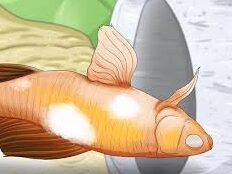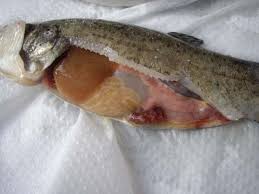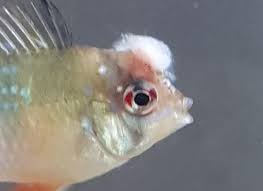Fungi are a group of organisms called heterotrophs that require living or dead matter for growth and reproduction. Unlike plants, they are incapable of manufacturing their own nutrients by photosynthesis. Fungi are present everywhere in saltwater or freshwater, in cool or warm temperatures. In most cases, fungi serve a valuable ecological function by processing dead organic debris.
However, fungi can become a problem if fish are stressed by disease, poor environmental conditions, poor nutrition, or injury. If these factors weaken the fish or damage its tissue, fungus can infest the fish. All fungi produce spores and it is these spores that readily spread disease.
The fungal spore is like a seed that is resistant to heat, drying, disinfectants, and the natural defense systems of fish. The three most common fungal diseases are discussed here. They are known as Saprolegniasis, Branchiomycosis, and Ichthyophonus disease.
Read Also: The Major Causes of Cannibalism among Poultry Birds
Overview of Fungal Diseases in Aquaculture

Fungal diseases are the fourth type of infectious disease. Fungal spores are common in the aquatic environment but do not usually cause disease in healthy fish. When fish are infected with an external parasite, bacterial infection, or injured by handling, fungi can colonize damaged tissue on the exterior of the fish.
These areas appear to have a cottony growth or may appear as brown matted areas when the fish are removed from the water. Formalin or potassium permanganate is effective against most fungal infections. Since fungi are usually a secondary problem, it is important to diagnose the original problem and correct it as well.
1. Saprolegniasis: Identification and Treatment
The disease is characteristic of white, cotton-like growth of fungus on the skin or fins of infected fish. Known as Saprolegnia sp., this fungus readily invades stressed freshwater fish but is not known to affect decorative fishes. Signs of fungal infection in fish are therefore less dramatic and often difficult to distinguish.
When present, the fungus appears on fishes as a fine film, dark pigmented areas, or a coating covering areas of the body or gills. This coating can easily be confused with similar signs caused by the presence of various types of parasites.
i. Saprolegnia sp
Saprolegniasis is a fungal disease of fish and fish eggs most commonly caused by the Saprolegnia species called “water molds.” They are common in fresh or brackish water. Saprolegnia can grow at temperatures ranging from 32°F to 95°F but seem to prefer temperatures of 59°F to 86°F.
The disease will attack an existing injury on the fish and can spread to healthy tissue. Poor water quality (for example, water with low circulation, low dissolved oxygen, or high ammonia) and high organic loads, including the presence of dead eggs, are often associated with Saprolegnia infections.
Among the most common and most easily diagnosed fish diseases is saprolegniosis. This is a fungal invader that reveals itself with a profusion of white, gray, green, or brown cottony tufts protruding from the fish’s skin. It can appear anywhere on the fish.
Saprolegnia parasitica infection in the fry and fingerlings of major carps is one of the main problems affecting the health of fishes. The disease in fish is characterized by a white to brown cotton-like growth consisting of colonies of mycelium and filaments, which appear as small to large patches on various parts of the body like fins, gills, mouth, eyes, or muscle.
The infection starts due to netting injury, overcrowding, or lesions caused by other diseases. Saprolegniosis in fish is primarily caused by one of three genera of aquatic fungi: Saprolegnia spp., Achlya spp., or Dictyuchus spp. All their basic characteristics are virtually identical, so it is best to think of them as a single fungal invader.
These fungi are found in all freshwaters worldwide and are always present in some form. Healthy fish easily control this fungus disease. The outer slime coat that covers a fish’s skin acts as a shield against fungal invasion. However, when fish are physiologically stressed or battling some bacterial or parasitic disease, they become susceptible to fungal invasion.
In this respect, saprolegniosis is not a primary disease but becomes a disease problem after some other serious health problem exists. Once saprolegniosis takes hold, it can pose a much greater risk to the host fish than the initial disease. The fungi spread vegetatively below the host’s skin tissues, and underlying muscles, flesh, and bone are exposed as the dead skin drops away.
ii. Disease Signs
Saprolegniasis is often first noticed by observing fluffy tufts of cotton-like material colored white to shades of grey and brown on the skin, fins, gills, or eyes of fish or on fish eggs. These areas are scraped and mounted on a microscope slide for proper diagnosis. Under a microscope, Saprolegnia appears like branching trees called hyphae. With the progression of infection, fish usually become lethargic and less responsive to external stimuli, making them targets for predators.
iii. Management and Control
Saprolegniasis is best prevented by good management practices such as maintaining good water quality and circulation, avoiding crowding to minimize injury (especially during spawning), and providing good nutrition. Once Saprolegnia is identified in an aquatic system, sanitation should be evaluated and corrected.
Common treatments include potassium permanganate, formalin, and povidone iodine solutions. Over-treatment can further damage fish tissue, resulting in recurring infections. Environmental management is essential for satisfactory resolution of chronic problems. Bath treatments in NaOH (10–25 g/lit for 10–20 min), KmNO4 (1 g in 100 lit of water for 30–90 min), and CuSO4 (5–10 g in 100 lit water for 10–30 min) are used.
2. Branchiomycosis: Gill Rot Disease in Fish
Branchiomyces demigrans or “Gill Rot” is caused by the fungi Branchiomyces sanguinis (carps) and Branchiomyces demigrans (pike and tench). Branchiomycosis is a pervasive problem in Europe but has been only occasionally reported by other countries’ fish farms.
Both species of fungi are found in fish suffering from environmental stress, such as low pH (5.8 to 6.5), low dissolved oxygen, or a high algal bloom. Branchiomyces sp. grow at temperatures between 57°F and 95°F but grow best between 77°F and 90°F. The main sources of infection are fungal spores carried in the water and detritus on pond bottoms.
i. Disease Signs
Branchiomyces sanguinis and B. demigrans infect the gill tissue of fish. Fish may appear lethargic and may be seen gulping air at the water surface (piping). Gills appear striated or marbled, with pale areas representing infected and dying tissue.
Gills should be examined under a microscope by a trained diagnostician for verification of the disease. Damaged gill tissue with fungal hyphae and spores will be present. As the tissue dies and falls off, spores are released into the water and transmitted to other fish. High mortalities are often associated with this infection.
ii. Management and Control
Avoidance is the best control for Branchiomycosis. Good management practices will create environmental conditions unsuitable for fungal growth. If the disease is present, do not transport infected fish. Great care must be taken to prevent the movement of the disease to non-infected areas. Formalin and copper sulphate have been used to help stop mortalities.
All tanks, raceways, and aquaria must be disinfected and dried. Ponds should be dried and treated with quicklime (calcium oxide). A long-term bath in Acriflavine Neutral or Forma-Green for seven days helps this condition. Ponds should be dried and treated with quicklime (calcium oxide) and copper sulphate (2–3 kg/ha). Dead fish should be buried.
Read Also: 15 MANAGEMENT TIPS FOR BETTER POULTRY PERFORMANCE
3. Ichthyophonus Disease: Fungal Infections in Freshwater and Marine Fish

Ichthyophonus disease is caused by the fungus Ichthyophonus hoferi. It grows in fresh and saltwater, in wild and cultured fish, but is restricted to cool temperatures (36°F to 68°F). The disease is spread by fungal cysts released in the feces and through cannibalism of infected fish.
i. Disease Signs
Infected fish may appear lethargic and exhibit a loss of equilibrium. In severe cases, the skin may have a “sandpaper texture” due to infection under the skin and in muscle tissue. Internally, organs may be swollen with white to grey-white sores. Diseased fish may show swinging movements, hence the term “swinging disease.” Severely affected organs include the liver, spleen, heart, kidney, gonads, brain, gills, and musculature behind the eyes.
ii. Management and Control
There is no cure for fish with Ichthyophonus hoferi, and they will carry the infection for life. Prevention is the only control. To avoid the introduction of infective spores, cultured fish should never be fed raw fish or raw fish products. Cooking helps destroy the infective stage.
If Ichthyophonus disease is identified by a trained diagnostician, infected fish should be removed and destroyed. Complete disinfection of tanks, raceways, or aquaria is recommended. Ponds with dirt or gravel bottoms may require months of drying to eliminate the fungus.
Aquatic fungi are often secondary tissue invaders that follow traumatic injuries, infectious agents, or environmental stressors such as poor water quality. Because many fungi thrive on decaying organic matter, they are common in aquatic environments.
Managing fungal diseases in aquaculture depends on maintaining proper water quality, minimizing handling injuries, and treating fungal infections early with approved compounds such as formalin and potassium permanganate. Prevention and early diagnosis are the most effective tools for managing fungal diseases in fish culture systems.
Do you have any questions, suggestions, or contributions? If so, please feel free to use the comment box below to share your thoughts. We also encourage you to kindly share this information with others who might benefit from it. Since we can’t reach everyone at once, we truly appreciate your help in spreading the word. Thank you so much for your support and for sharing!

